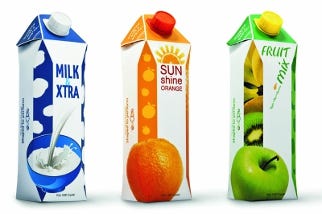Beverage packagers: It's time to think small
January 29, 2014
As 2013 planning season draws near, businesses will again intensely think about what consumers might want and need. Competition will continue to intensify and we will all continue to look for uncontested market spaces where we can add value. These spaces are increasingly hard to find, yet the emerging small household demographic represents such a space.
Our market rules are undergoing great change and will be altered by a new dominant and growing demographic. The "family brand" is still relevant, but may not yield the greatest new growth and profit. Those that reach, engage and design products for this new demographic will be the real winners in the marketplace and with shareholders, but clearly an internal and external market transition will be necessary.
That's because it isn't easy to embrace a new, and very different, reality. But the model American family—with mom, dad and the kids living under one roof-is fading. In every state, the numbers of unmarried couple, childless and single-person households are growing faster than those comprised of married people with children. According to 2010 U.S. Census Bureau figures, single- and two-person households now comprise 65 percent of all American households. And out of 112.3 million U.S. households in 2008, data from the OECD reflects a stunning new reality: over 60 percent of them have no children. These smaller households will continue to dominate the American demographic landscape and change every aspect of the way we live.

Small households infographic
For beverage manufacturers, this signifies a sea change: it's time to think small. Not surprisingly, one- and two-person households have very different needs from families with children, and America is "small-sizing"—or "right-sizing"—in every category thanks to these demographic changes. Our shrinking homes, cars, stores, electronics and portion sizes prove the point.
•The median size of new single-family homes dropped consistently from a peak of 2,268 square feet in 2006 to an even 2,100 in 2009, notes the National Assn. of Home Builders (NAHB). More telling were the results of a 2010 NAHB survey: 52 percent of builders expected to produce smaller homes in 2011, compared to only seven percent who expected to build larger ones.
•Small cars have gone from 14 percent of the market in 2004 to 21 percent in 2009. In March 2010, Automobile magazine cited baby boomers and the generation between 15 and 30 as the two biggest demographic groups driving the small car trend. Ford product development chief Derrick Kuzak called the trend "right-sizing," noting that people are buying cars that are as big as they really need.
•On the retail front, the major players are reformatting their facilities for a variety of reasons that relate to smaller households. Walmart Express, a compact new format for the retail giant that averages 15,000 square feet per store as opposed to the usual 185,000 sq ft, debuted in 2011 and another 350 are planned for this year, in part to enter urban markets, notes Independent Retailer.
For the beverage market, this means supersize and multi-serve containers are moving to the sidelines as the demographically driven trend to "small-size" gains momentum. The research consultancy Hartman Group identified this trend in 2006, noting, "as America's households increasingly involve 3 or fewer people, the scope for multi-serve packaging itself starts to look quite bleak."
But embracing this new order and effecting change may not be easy for manufacturers thanks to the complexity of this demographic, which is a diverse group that runs the gamut from recent college graduates to retirees. They can be single, widowed, cohabitating or married. But most fall into two segments—Millennials, now 18 to 34, and Baby Boomers, 45 to 65.
•For many, the Millennials are the most inexplicable. They are self‐absorbed and self-reliant, with a strong sense of independence and autonomy. Eight key values ascribed to this group are choice, customization, scrutiny, integrity, collaboration, speed, entertainment and innovation. They were also born into a technological, electronic and wireless society where computers are the norm in the home and schools, and media has made global boundaries more transparent. And 40 percent are multicultural, according to a 2010 report from Pew Research Center.
•Boomers have defined themselves by their careers, and while some have retired, many plan to expand into active retirement by re-engineering life. They are also more tech-savvy and are into health and wellness continually seeking the fountain of youth. They also have a significant percent of the young Millennials living at home.
Yet the small household demographic has strong consumption patterns and unmatched purchasing power. This past January, CNN Money reported that consumption by singles contributes $1.9 trillion annually to the economy, according to the U.S. Bureau of Labor Statistics. Doing the math (footnote below), it's possible to extrapolate that two-person households spend $1.5 trillion annually.
These characteristics, combined with such tremendous purchasing power, have strong marketing implications for manufacturers—from the importance of social media marketing and the products they offer to the packages and sizes they offer them in. And all require manufacturers to think differently and innovate.
New products created for this group may be fundamentally different than what has been offered in the past. Both the health-oriented Boomers and multi-cultural Millennials like variety and flavors. And they are more worldly thanks to the Internet. That means they want products that speak to them and fit their lifestyles.
Often, these are "all-natural blends of 100 percent fruit and vegetable juices that incorporate bold, fresh flavors and health-oriented functional ingredients," notes Jim Carper, editor-in-chief of Dairy Foods magazine. Most popular right now are pomegranate and acai juice for their antioxidants, and vitamins, whey protein, minerals, fiber, electrolytes and prebiotics and probiotics for their health benefits, he notes. Also high on the radar are flavored waters with functional ingredients, which are "milk's number one competitor in sales for share-of-stomach right now," adds Carper. Coconut water, which is high in electrolytes, is a huge front-runner in the market. The insights above simply reinforce the need for real innovation.
Packaging these new products will also require creative thinking and innovation. All segments of this group know what they want, have a strong sense of independence reflected in their propensity to often live alone and are immersed in mobile, busy lifestyles. These characteristics prompt them to choose more compact or handheld packaging that is also sleek and graphic to express "who they are."
"Grab-and-go is the biggest trend for beverage manufacturers right now because these products are consumed away from home. But there's also a growing demand for smaller packs that hold several servings, rather than giant, family-sized containers, " notes Carper. "This kind of sizing speaks to smaller-size households and the individualization that specific products for specific members of the household require.
But beyond mobility, packaging has a host of other marks to meet, especially since it must grab a consumer's attention within 10 seconds to influence purchasing behavior notes the market research guidebook GreenBook. And it must communicate the right message for its cohort, since consumers look for various packaging attributes based on their age. A Mintel report titled "Beverage Packaging Trends" released this past January found that consumers 25 or younger show a high acceptance for stylish, unusual designs and are less likely to rate health and nutrition attributes as important, while those over 55 want simple, easy-to-read beverage labels and pay close attention to health claims.
And finally, packaging must also keep environment in mind. Demand in the U.S. for green packaging, which consists of recyclable, renewable and biodegradable content, is expected to increase 3.4 percent annually, notes market research firm Freedonia Group.

Tetra Pak carton designs
This places a tremendous burden on the supply chain partners that produce and design these packages. They must innovate to create a range of user-friendly products that embrace a range of traits, such as individualization, grab-and-go portability; easy-to-use caps; color, printing and shape options; and innovative design. All allow brands to differentiate themselves and stand out in the sea of sameness on shelves. They must also clearly maintain product integrity and safety and communicate brand message, which is subject to demographics. At Tetra Pak, we are listening to our customer and the consumer globally that are driving these changes. Several of our packages, including but not limited to the Tetra Brik Aseptic Edge in 200 ml and 1000 ml, are examples of this.
And of course, manufacturers must tap into marketing trends that will effectively sell their products. Social media marketing is a phenomenon that can't be ignored--especially since user generated content (UGC) affects purchase decisions. According to a study from market research firm Bazaarvoice, UGC influences 84 percent of Millennials and 70 percent of Boomers. And this trend will increase as Millennials attain more buying power than any other segment of the population by 2017, they note. So as brand marketers, it is critical to be transparent and engage these consumers on- and off-line, since they will "market" their products to each other. For instance, the study also notes that 71 percent of Millennials share their opinions because they believe others value them.
Clearly, the hurdles to moving forward in this new marketplace are challenging. But the most significant point to keep in mind is that small-sizing is here to stay, and the one- to two-person household will effect what, where and how products are purchased.
And for now, one thing is clear: A manufacturer that hopes to succeed in this new marketplace, and win sales from this valuable demographic, must have all parts of this puzzle in place. So as planning season begins, it's time for them to fully assess their existing capabilities and those of their suppliers to understand the magnitude of this change.
It may be necessary to step-up internal innovation and strategic focus to target small households and fulfill consumer needs and wants; partially or fully overhaul existing plants to accommodate these new products; rethink the supply chain from adjusting channels of distribution to collaborating with suppliers in new ways; and market in new ways, though different and changing channels, to educate retailers on the importance of small-sizing.
Footnote: Estimated value using average annual expenditure for two person households with no children ($28,017), multiplied by singles' purchasing power (1.9 trillion), divided by average annual expenditure for single person household (34,471).
Source: Tetra Pak
.
About the Author(s)
You May Also Like


